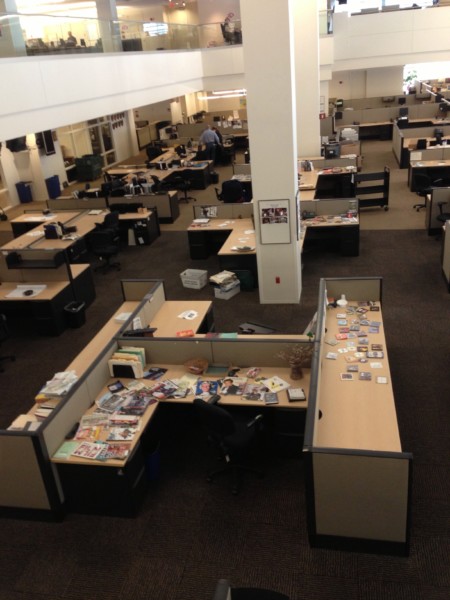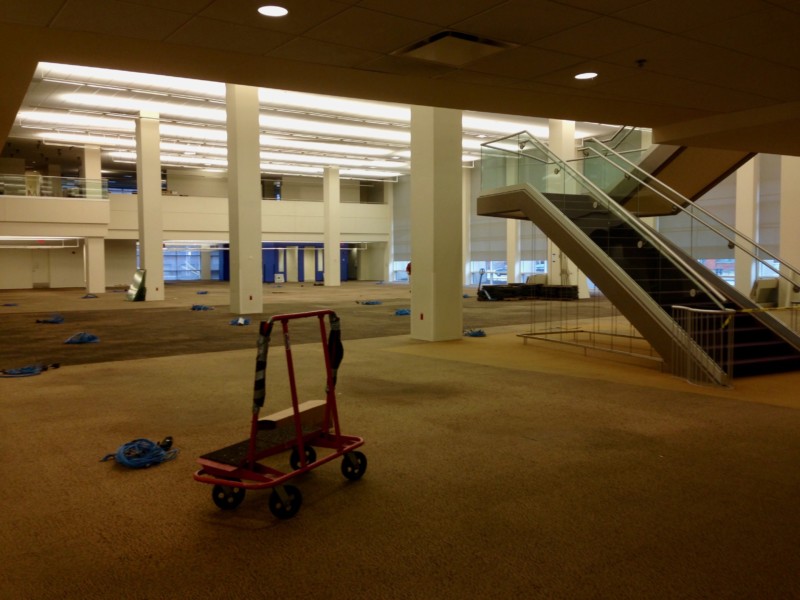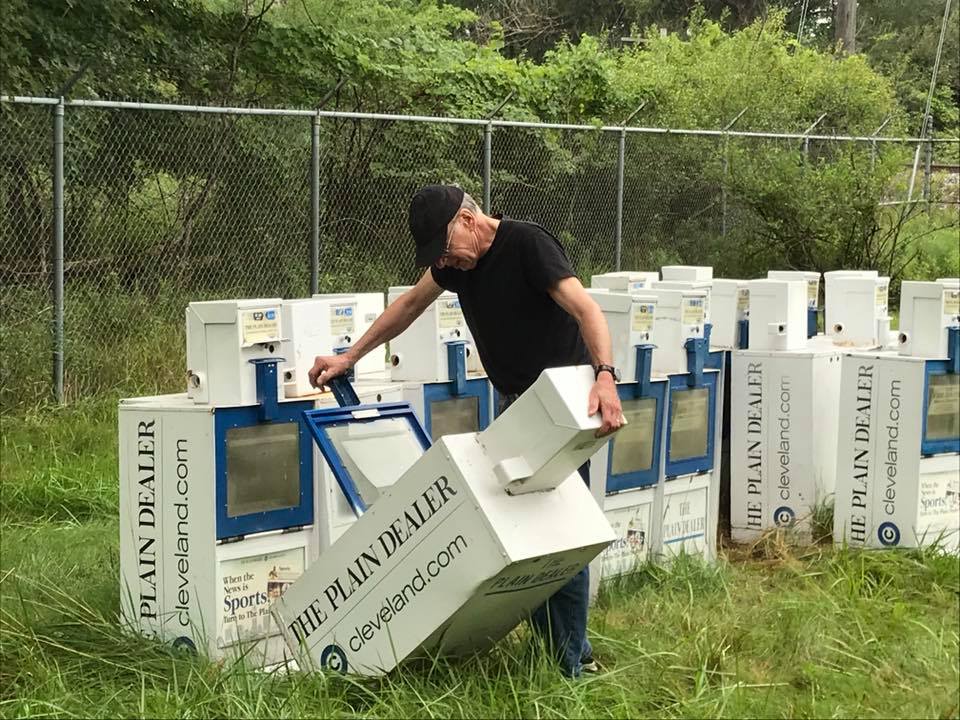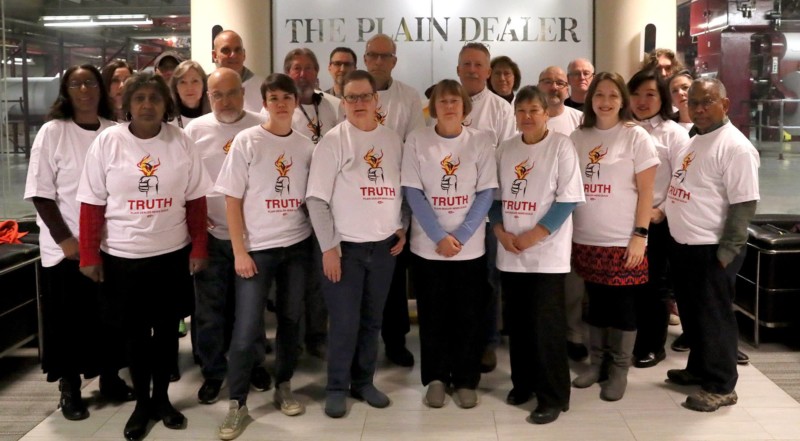Sign up for the daily CJR newsletter.
As a new intern at the Plain Dealer, Scott Stephens signed his first union card in the summer of 1981. It was a good time to be a journalist in Cleveland. The Sunday edition was several hundred pages long and included a glossy weekend magazine. The first-year pay scale, $305 a week, “seemed like a king’s ransom,” Stephens recalls. On his first day, he was invited to lunch at the Headliner, a local bar that doubled as the unofficial office for the Newspaper Guild.
For Stephens, journalism and unionism were intertwined; the latter seemed to ensure the quality of the former. “Some of the most vocal Guild people were also the best journalists in town,” Stephens says.
In the decades since, he and many others worked to build on the legacy they inherited at Local One, home of the inaugural charter of what’s now known as the NewsGuild. But even as momentum for unionized journalism has surged nationwide, the picture is very different in the city that drafted the blueprint.
In April, Advance Local—which owns the Plain Dealer as well as Cleveland.com, a non-unionized digital news operation—laid off twenty-two Plain Dealer staffers. (Advance positions Cleveland.com as a separate media entity, though stories from both newsrooms have always appeared on the same site and print paper.) Of the fourteen who remained, most were told that they’d be moved to out-county beats, and no longer allowed to cover Cleveland, Cuyahoga or Summit counties, or the state. Cleveland-area reporting would largely fall to the non-union Cleveland.com staff. Faced with these conditions, ten more Plain Dealer staffers accepted layoffs.
Tim Warsinskey, a former Guild leader less than two months into his editorship, emphasized that this last group “made personal decisions to voluntarily leave the Plain Dealer. I respect them and their decisions.” Taken together, Warsinskey wrote, “these two newsrooms still have nearly 70 journalists…[a number] on par with some of the leading, similar-sized papers and websites in the Midwest.”
The Guild disputed this characterization, saying in a statement that journalists were put in an impossible position.
“We’ve had a lot of guilt about the way things turned out,” said Rachel Dissell, an investigative journalist and former Guild Leader, in an April 15 interview. “We obviously didn’t want it to end this way. This is the only job I ever wanted.”
On Tuesday, the Cleveland guild announced a decision by Advance to lay off the four reporters who had remained at the Plain Dealer. “After more than 80 years of union membership, Plain Dealer journalists will no longer be represented by Local One,” the guild statement read. “The unit will be dissolved effective May 17. The PD newsroom will no longer exist.” The final four Plain Dealer staffers were offered positions at Cleveland.com, whose staff will continue to publish online and in a daily paper that uses the Plain Dealer masthead.
“Before anyone starts pounding nails in coffins, as some of my more sensationalist brethren and harsh critics are wont to do, take a breath. This is not the end of The Plain Dealer,” Warsinskey wrote in a column. If the four accept the jobs, Cleveland.com “will have 64 journalists and content producers.” In the same column, Warsinskey announced news of his own: in June, he’ll move to a new job, higher up in the Advance chain.
The gutting of Local One in Cleveland sits uncomfortably against the fact that the NewsGuild has brought in nearly three thousand new members in the past couple of years. The Writers Guild of America represents twenty-five hundred more journalists. Newsrooms from the South Bend Tribune to the Orlando Sentinel are campaigning for their first-ever unions, and recently, the Roanoke Times and the Idaho Statesman backed unions by overwhelming votes.
“People are really eager because they’re trying to save something when companies are just strip-mining news outlets around the country with no real vision,” says Jon Schleuss, NewsGuild’s president, who helped bring a union to the Los Angeles Times when he was a reporter there. Journalists, he added, “have had enough.”
In Cleveland, protections won through collective bargaining have made a difference. Those who were laid off will receive two weeks of severance pay for each year of service, up to one year of pay. There are also “enhanced benefits” that the Guild negotiated, according to Edd Pritchard, Local One’s president. Those who were laid off in the midst of the coronavirus pandemic can receive health insurance benefits until February 28, 2021, so long as they sign a non-disparagement letter. Photographers can also keep their equipment, often worth thousands of dollars, and use it to kick-start their next opportunity. That, according to the Guild’s attorney, is also contingent on signing a release, as well as an employee-by-employee, equipment-by-equipment review by the employer.
But the hits have nonetheless taken a breathtaking toll. “To those Guild members who came before us: We are sorry,” read the Local One statement. “To the city and people of Cleveland and Northeast Ohio: We will miss you. We did our best.”
Employees ask year after year, How much more can they cut? But then I got it. It doesn’t end.
DEPRESSION-ERA JOB LOSS and wage cuts inspired Cleveland newspaper workers to take a stand in August 1933. Staffers at three papers formed the Cleveland Editorial Employees’ Association, and read from a mimeographed leaflet at their first meeting:
Squeezed between the pressures of advertisers and stockholders, between the exorbitant tolls of syndicates and press services, and the unionized requirements of the mechanical trades, newspaper editorial employees have from industry’s infancy been the most notoriously exploited of all producer groups in this country. They have submitted to this not only uncomplainingly, but in fact quite happily, clinging to an old local room tradition.… It is now time that local room staffs start living and working for something more than the byline and pat-on-the-back. [The National Recovery Act] holds out to them their first bona fide opportunity to go after realities.
The Clevelanders became part of a broader movement that formalized as a national newspaper guild in December that year. Today, the NewsGuild represents about twenty-four thousand people in the United States and Canada. Most work in media—from the Casper Star-Tribune to the San Francisco Chronicle to the Canadian Broadcasting Corporation to Reuters.
By the time Stephens returned to the Plain Dealer in 1990, he knew it as a destination paper where staffers could earn a living, raise a family, and buy a house while serving their community. The union had also surmounted significant hurdles. The Cleveland Press, the afternoon paper, had folded in 1982. To make up for lost membership, the Cleveland Newspaper Guild reoriented as the Northeast Ohio Newspaper Guild, bringing in members from Akron, Massillon, Canton, and a local Catholic bulletin.
Around the same time, the Guild hosted an “informational picket” of its own paper to protest a “lawyer-brokered front-page story that retracted a two-part series authored the previous year by reporter Walt Bogdanich,” as described in Plain Dealing: Cleveland Journalists Tell Their Stories. The stories by Bogdanich, who later won three Pulitzer Prizes for his work, showed how a Teamsters boss had taken kickbacks and served as an informant. The retraction, which had no byline, was later discovered to have been arranged by the Mob and written by the executive editor.
Stephens served on the bargaining team for a new contract in 1996, and then for ten years as unit chair. He was also elected to the Guild’s International Executive Council.
The 1996 contract was unusual, he says, even for an era when “newspapers were seemingly printing money and the Plain Dealer was doing very well.” The publisher invited the staff to parties at the Cleveland Zoo, Stephens remembered in his chapter for Plain Dealing, with an open bar, endless hors d’oeuvres, and unlimited Dove bars for children.
The contract had a ten-year term that was “unheard of at the time,” Stephens says. But the company was building a spacious new headquarters and a production plant. It needed predictable labor costs to manage its financial commitments.
Stephens feels that the contract was a good one, “but it did lock us in,” he says. Even in those days, there were signs that the flush accounts weren’t going to last forever.
News chains were consolidating, which led to ownership moving further from the core purpose of local journalism, as Stephens saw it. “Corporations were more interested in their stocks doing well than in having a personal stake in the community,” he says. Meanwhile, a massive newspaper strike in Detroit had no end in sight, and the brand-new internet introduced big questions about business models that still haven’t been answered.
When the Cleveland contract expired in 2006, the Plain Dealer offered buyouts to veterans with many years of service. As Stephens remembers, they were very generous, offering two and a half years of pay and benefits.
Another round of buyouts came in 2008, this time with a targeted number of cuts. Stephens and his wife, a photographer, both accepted, as did others, but not enough to stave off twenty-seven layoffs—writers, photographers, copy editors, and support staff. These were the first layoffs in the history of the paper.
A year later, as a national recession worsened, the company said that the union needed to accept a 12 percent wage decrease if it wanted to stop at least sixty more people from being laid off. Members voted for the wage cut.
“I naively thought that after owners got their pound of flesh that maybe they would leave us alone for a while,” wrote Harlan Spector, the unit chair at the time, in Plain Dealing. He had accepted a voluntary layoff. “Employees ask year after year, How much more can they cut? But then I got it. It doesn’t end.”
Staff attrition shrank the paper further. In 2013, big cuts were announced—more than a third of editorial staffers—although the Guild did sign a six-year contract that raised wages by 8 percent and staved off additional job loss.
After many volunteered to accept a severance package, management sent a letter by email attachment to staffers that advised them to sit by the phone between eight and ten the next morning to await word on whether they’d keep their jobs. Altogether, another fifty-plus Guild members lost them.

The Plain Dealer newsroom in 2013, before print staff was separated from Cleveland.com staff. Photo used with permission.
THE UNION SOLDIERED ON, but circumstances changed drastically. When Stephens left in 2008, Cleveland.com was essentially the website for the Plain Dealer, as NYTimes.com is where one goes to see New York Times stories. A few people were hired solely under the digital arm, but, as Stephens remembers, these were mostly technical positions.
This shifted as management made ever stronger delineations between the Plain Dealer and the digital-only arm that it initially called the Northeast Ohio Media Group. During the 2013 layoffs, as CJR wrote at the time, the company planned to offer positions in the other newsroom to some Plain Dealer staffers who lost their jobs. The company began to divide beats between the two.
Soon after came the physical separation. The newsroom headquarters at 1801 Superior Avenue, built in 1999, was emptied of journalists. Cubicles were torn out as the company urged staffers to take up “backpack journalism,” out in the community. While designers and copy editors moved to a suburban production plant, reporters and editors were given iPhones, laptops, and backpacks to encourage them to work from home or at cafés.
Plain Dealer employees were eventually dispatched to a downtown office in the Tower City complex. The Superior Avenue newsroom was remodeled, and the Cleveland.com staffers were invited back into the headquarters. The Plain Dealer ended up moving again in 2018, from Tower City to the production plant.
The two-newsroom structure led to strange situations where, for example, photographers for both the Plain Dealer and Cleveland.com showed up for the same assignment. There was some beat overlap in coverage of city and county government, real estate development, and the arts. Staffers were discouraged from talking to one another. To communicate, they’d have to go through an editor, though some information quietly passed between journalists to help ease confusion.
Dissell emphasized that Cleveland.com reporters are committed to doing the best journalism they can. Still, the arrangement was an inefficient use of company resources and confused people in the community, Stephens says.
“Advance has very deliberately made Cleveland.com into a separate news-gathering entity, and a nonunion entity,” Stephens says. “So while they are increasing the numbers there of nonunion news gatherers, there is continued reduction of unionized staff at the Plain Dealer. It’s union-busting.”
Advance, a privately held company, has presented its local news strategy as digital first, and it has largely stuck to it. In Massachusetts, for example, it split the 196-year-old Springfield Republican and MassLive into separate companies. It drew scrutiny for a similar strategy with the Times-Picayune and Nola.com in New Orleans. Last year, the Times-Picayune was absorbed by the Baton Rouge Advocate, part of a long-term effort by a publication that saw an opportunity to compete. The Advocate now publishes a New Orleans print paper seven days a week, alongside a coordinated digital outlet.
“We made mistakes, a lot of them,” Randy Siegel, then-president of Advance Local, told Poynter last year, “but we are pleased with our progress and happy with where we are.”
In 2019, after a “no layoff” clause expired, another third of the Plain Dealer’s unionized staff were laid off, including one journalist who wrote about the cuts as his last dispatch after thirty-seven years of reporting. A contract extension to 2021 kept protections for overtime, vacation, and severance pay; eliminated unpaid furlough days; and provided an option for laid-off staff to extend their healthcare benefits. The Guild, which had filed an information request about outsourced production jobs, gave up the right to file a grievance about the matter.
Then came this year’s losses, which eliminated the final members of a newsroom that employed more than three hundred fifty staffers two decades ago.
“The layoff may have ended my thankful time in newspapers, but it did not end my dedication to story telling,” Branson Wright, a longtime Plain Dealer sports reporter, wrote in a Facebook post. Music critic Chuck Yarborough shared the column he was never able to publish. Grant Segall, a 35-year veteran, interviewed himself about his robust career in a variation of his “My Cleveland” column:
Why’d you finally leave The PD?
Grant: I survived three rounds of layoffs but not a fourth.
What now?
Grant: I’ll keep writing until my fingers or my brain freeze up.
Writing for who?
Grant: I’m working on that.
“When someone loses their job, it’s easy to think ‘I didn’t do enough,’ ” said Ginger Christ, the unit chair who was among the last ten to leave, in an April 15 interview. Christ, a healthcare reporter, was covering a news conference about a potential statewide shutdown during the coronavirus pandemic when she got word of the first round of layoffs. (She wrote two stories that day, and another that evening.) Within about twenty minutes, the layoffs were announced on Cleveland.com, in a note from Warsinskey citing financial pressures on the news industry. Many staffers heard the news first from sources, friends, and family before a Guild representative could reach them, Christ said.
It’s like any profession. You don’t lose your best and your brightest and get better.
With the Ohio shutdown in force, the traditional solidarity gathering happened by Zoom. Appearing as “little squares of faces,” Dissell said, they drank together. There was a new intimacy: you could see what drinks people had at home and what their personal space looked like. But the support from past staffers who often came out for these rituals was missed.
Dissell grew up in Cleveland as the oldest of six children in a family she described as “very, very poor.” She didn’t expect to attend college, but a high school journalism teacher paid for the application that eventually brought her to Kent State University, where she studied journalism. She interned at the Plain Dealer in 2000, before she was old enough to drink. It was important to her to work in the place she was from.
Dissell came to focus on trauma and accountability journalism; she’s a two-time winner of Dart Awards for Excellence in Coverage of Trauma. After being laid off, she’s still receiving responses to her public-records requests. As a Guild leader, she found that the bargaining table brought a sense of agency and power that she felt she had lacked growing up.
The latest cutbacks drew criticism from other journalists, readers, more readers, and community leaders. An April 7 letter to Warsinskey from the executive director of a local nonprofit reads, in part:
One of my first conversations upon taking on leadership at Slavic Village Development was with Rachel Dissell, who in an hour taught me more about my new neighborhood than I had known for the past decade. I’ve had the pleasure of working directly with Steven Litt, Michelle Jarboe, and Jordyn Grzelewski on multiple stories covering the re-emergence of Broadway Slavic Village. Lisa DeJong’s photographs illustrated a community in ways beyond words. All of this knowledge is lost, and these deep, important relationships have been severed for an unknown goal.
What an utter, utter loss for all of Cleveland.
“It’s like any profession,” Stephens says. “You don’t lose your best and your brightest and get better.”
While staffers are heartbroken to lose their jobs, Dissell said, it comes with an acute awareness of how others are in worse positions. In some of their last stories, Plain Dealer reporters spoke to restaurant workers who were packing up food and taking it home with them before locking their doors, as well as to frontline social workers at risk of layoffs from beleaguered nonprofits. “We’re not any more important than those folks,” Dissell said.

The Plain Dealer newsroom at Superior Avenue, shown here in 2013, was eventually renovated for use by Cleveland.com staff. Photo used with permission.
JOURNALISM IS STILL HAPPENING in Cleveland, as everyone I spoke with emphasized. The Cleveland Jewish News, the alt-weekly Scene, Crain’s Cleveland Business, and Belt Magazine are among the other outlets still reporting. Public radio has deepened its news-gathering efforts over the years.
There are also talented reporters at the Cleveland.com newsroom. However, Advance has also announced furloughs, pay cuts, and suspended 401(k) contributions, citing the need for cost savings in the face of the coronavirus. A letter to the staff from CEO Caroline Harrison said that the changes would be temporary. “We were on a positive track before the pandemic hit us,” she wrote.
Meanwhile, the movement for unionized journalism goes on. In Chicago, the young union at the Tribune is among the NewsGuild chapters battling against substantial cuts by Tribune Publishing, where Alden Global Capital has a majority stake. And Local One is still alive in Ohio, with nearly one hundred thirty members. It represents newsroom, advertising, circulation, and production employees at the Canton Repository and the Independent in Massillon, as well as the Akron Beacon Journal newsroom—all Gannett outlets. As part of the agreement signed this week, Local One will not attempt to organize Cleveland.com for one year. Other local unions and the NewsGuild, however, can do so.
The global health emergency has underscored the importance of newsroom organizing, said Schleuss, the NewsGuild president.
“Want better protective equipment?” he says. “You can bargain over that collectively. Want guaranteed sick time? You can bargain that collectively.” Journalists are another kind of first- responder, Schleuss said. To that end, the NewsGuild is pushing for the news industry to be included in the next stimulus package.
In this economy? In this pandemic? I’m damn proud.
I asked people how to reconcile the hope for a new era of organized journalism with the saga of Local One in Cleveland. I heard about how “organizing never stops”—and that it’s important to be mindful of when entirely new jobs are created, such as social media positions or engagement editors. Locals choose whether to include them, or not, in their organizing.
I heard about how some feel that the owners of media companies, like the Newhouse family that owns Advance, need to take responsibility for their part in putting news outlets in a precarious position by reacting slowly to the digital age, perhaps assuaged for too long by big newspaper profits. As Sam Allard of the Scene pointed out, the Newhouses recently purchased the Ironman brand for $730 million in cash.
I heard about the worth of bargaining even when, or especially when, circumstances seem desperate. Christ said that protections can give reporters more freedom to cover challenging stories. And Dissell said that laid-off staffers are leaving with severance packages that were hard-won by the people who had fought for them for years.
The two weeks’ pay for every year they worked at the Plain Dealer—“We held on to [that] for dear life,” Dissell says. The ten months of fully paid healthcare—“In this economy? In this pandemic? I’m damn proud.”
And, to a person, I heard about the worth of going to the line for quality journalism. Reporters do essential work by “informing a participatory democracy,” says Stephens. “It really does depend on that.” Or, as Schleuss put it, mediums and business models change, but the constant is this: “Humans want stories, and we’re able to provide news stories.”
Update: CJR has clarified its headline after receiving a note from Warsinskey. “The Plain Dealer Publishing Company still is a separate company from Advance Ohio, which operates cleveland.com and supplies the local content for The Plain Dealer. The Plain Dealer newsroom will effectively close, but The Plain Dealer Publishing Company is still very much in business, and will continue to publish and distribute The Plain Dealer.”
Has America ever needed a media defender more than now? Help us by joining CJR today.








